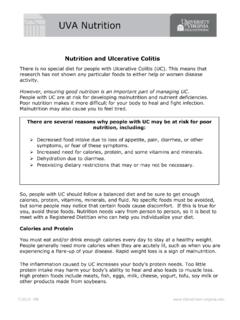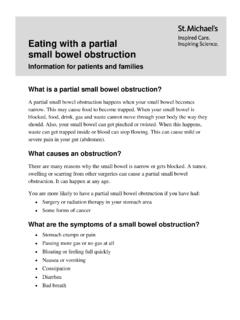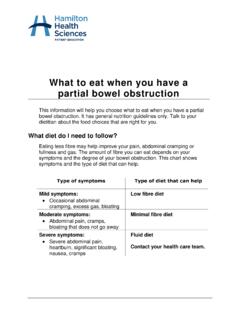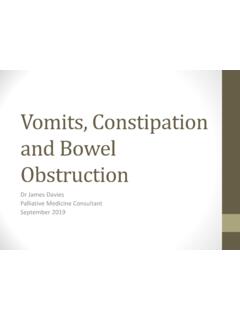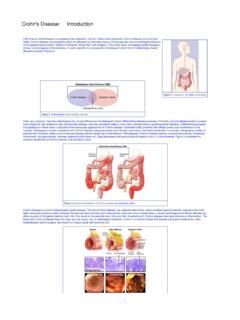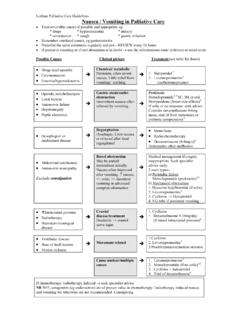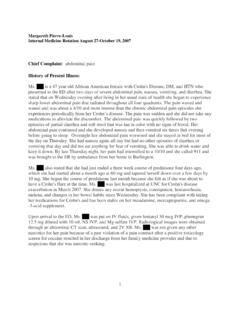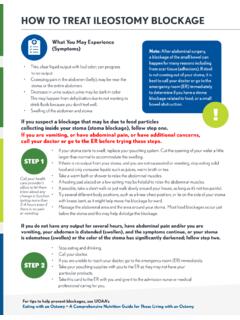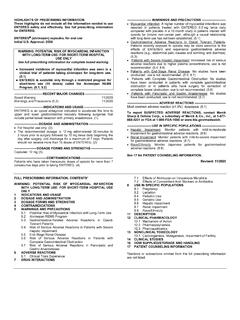Transcription of Diet Advice to Manage a Partial Bowel Blockage 2019
1 This information is not meant to replace the medical counsel of your doctor or individual consultation with a registered dietitian. This information may only be used in its entirety. Authorization given to reproduce this information with acknowledgement to Oncology Nutrition, BC Cancer Agency July 2019 1 Diet Advice to Manage a Partial Bowel obstruction A Partial Bowel Blockage can occur if an area of the Bowel is narrowed due to: hardening of the Bowel wall cancer within the Bowel area outside pressure on the Bowel swelling/inflammation of the Bowel When this happens, digested food cannot easily pass through the narrowed area of the Bowel . This may cause symptoms such as nausea/vomiting, heartburn, stomach fullness/bloating, abdominal cramps/pain, or change in Bowel habits. Some of these symptoms can last for a short time or be an ongoing concern. This handout provides helpful tips and food ideas which may provide some relief to these symptoms when part of your Bowel is blocked or at risk of becoming blocked.
2 Type of diet needed Your doctor or health care provider may recommend a low fibre or liquid diet based on your symptoms and your dietitian can help you to make appropriate food choices. This table describes common symptoms and suggests the best diet to follow to help provide some relief to your symptoms. Levels Symptoms Diet to follow Level 1 Increased gas, bloating, stomach cramps, mild pain Low Fibre diet (see page 3) Level 2 Constant daily symptoms Feel full quickly with meals, heartburn, persistent stomach pain and cramps, bloating with nausea Liquid diet (see page 9) If you have been on a liquid diet for more than 5 days, contact your dietitian for supplementation. Level 3 Acute or severe symptoms Severe stomach pain requiring pain medication Nausea and vomiting Weakness Call your doctor or go to your local emergency department. This information is not meant to replace the medical counsel of your doctor or individual consultation with a registered dietitian.
3 This information may only be used in its entirety. Authorization given to reproduce this information with acknowledgement to Oncology Nutrition, BC Cancer Agency July 2019 2 General Advice How to eat through the day o Eat or drink small amounts every 2 hours. Large meals can cause more discomfort. Try to have 6-7 small meals or snacks spread out through the day. o Cut foods into small pieces. o Chew foods well and eat slowly. What to eat through the day o Follow a Low Fibre Diet or a Liquid Diet. o Avoid any food that is tough or stringy (celery, tough meats). o Well-cooked vegetables, fruit and meat may be tolerated better. Use moist cooking methods (simmer, poach, stew, roast) versus dry cooking methods (grill, broil, barbecue). Sometimes pureed foods may be easier to digest. Aim to consume at least 6 cups of liquid through the day o Sip liquids throughout the day instead of drinking large amounts at one time.
4 O Do your best to drink as much as you can between your meals and snacks (juices, broths and water). o If you are losing weight, choose higher calorie liquids such as milk, yogurt drinks, cream soups or milkshakes. Take a multivitamin and mineral supplement if your diet is very limited. Ask your dietitian or local pharmacy about the best one for you. Try to take a short walk every day to help your bowels move. Take Bowel medications as advised by your doctor to promote regular and easy to pass Bowel movements (see page 8). Keep a food and symptom journal of the time what you ate and how you felt to help identify patterns of eating or foods that do not agree with you. Take note of the time of day, what you ate and how you felt. Experiment with foods and add them into your diet one food at a time and in small amounts. Avoid any foods that make you feel worse. If your symptoms become worse, try drinking only liquids for a few hours to help settle your stomach.
5 When you feel more comfortable, re-introduce low fiber foods back into your diet in small amounts. If these diet suggestions are not helpful, follow up with your doctor or dietitian for guidance. This information is not meant to replace the medical counsel of your doctor or individual consultation with a registered dietitian. This information may only be used in its entirety. Authorization given to reproduce this information with acknowledgement to Oncology Nutrition, BC Cancer Agency July 2019 3 Low Fibre Diet Information Follow a Low Fibre Diet to help reduce abdominal cramping, bloating and diarrhea. Avoid foods with more than 2 grams of fibre per serving. Read labels for fibre content on pre-packaged and prepared foods and take note of the serving size. Use this table: Note: If there are foods in the you may choose column that do not agree with you, then you should avoid them. Hot Cereals Avoid You may choose Red River Sunny Boy Oatmeal, cup cooked Cream of Wheat , 1 cup cooked Cold Cereals Avoid You may choose Cereals with more than 2 grams fibre/serving Examples: All Bran , Bran Buds , Bran Flakes Fiber1 , granola Cereals with less than 2 grams fibre/serving Examples: Cornflakes , Rice Krispies , Special K This information is not meant to replace the medical counsel of your doctor or individual consultation with a registered dietitian.
6 This information may only be used in its entirety. Authorization given to reproduce this information with acknowledgement to Oncology Nutrition, BC Cancer Agency July 2019 4 Breads and Baked Goods Avoid You may choose Breads and baked goods with more than 2 grams of fibre per serving Breads labeled as a high or very high source of fibre Any product made with 100% whole wheat flour (bread, bagel, pita, tortilla) Baked goods made with nuts and seeds Bran muffins Sprouted whole grain bread Dark rye bread* Naan or roti bread* Pumpernickel bread * *means it may cause gas for some people Breads and baked goods with less than 2 grams of fibre per serving. In general, those made with white flour are well-tolerated Examples: Bread made with white rice flour Hamburger/hotdog buns Spelt bread, sourdough, panini White bread, muffins, bagels, pita 60% Whole wheat bread Light rye bread White English muffins White flour tortillas White pancakes and waffles Pastas and Noodles Note: Have 1 cup or less of cooked pasta or noodles per meal Avoid You may choose Pastas with made with whole wheat flour Smart pastas with added fibre Pastas made with white flour.
7 Examples: Egg noodles, macaroni, rice noodles, spaghetti , fettuccini Grains Avoid You may choose Barley Brown rice Bulgur, buckwheat Corn meal or polenta Natural bran, wheat germ Popcorn Quinoa Wild rice Graham wafers, digestive biscuits, kasha, stoned wheat thins Couscous * *means it may cause gas for some people Rice, corn or quinoa cakes Soda or Ritz crackers White rice Pretzels and pretzel crackers Social tea biscuits, melba toast This information is not meant to replace the medical counsel of your doctor or individual consultation with a registered dietitian. This information may only be used in its entirety. Authorization given to reproduce this information with acknowledgement to Oncology Nutrition, BC Cancer Agency July 2019 5 Nuts and Seeds Avoid You may choose All whole and ground nuts, such as almonds, hazelnuts, soy nuts, etc. All whole and ground seeds, such as chia, flax, sesame, sunflower, etc.
8 Coconut Products containing nuts and seeds, such as trail mix, granola and granola bars Smooth nut butters (peanut, almond , cashew) Note: Have only 1 tablespoon of nut butter at a time Tahini Beans and Lentils Avoid You may choose All legumes * Examples: Beans ( kidney, black, navy, lima, soy) Peas (chick peas, split peas, black-eyed) Lentils Edamame beans *means it may cause gas for some people None Fruit Note: Remove all skins, membranes and seeds from your fruit. Cooked or canned fruit is usually tolerated better. Avoid You may choose All dried fruit, such as dates, prunes, raisins, figs, and dried apricots. Fresh, frozen or dried blackberries, blueberries, raspberries, and cranberries Other fresh fruit that should be avoided include: Avocado Grapes Papaya Pomegranate Orange Rhubarb Apple with skin* Cherries * Persimmon* Start with 1 serving per day; Limit to 2 servings per day (1/2 cup portions) Applesauce Bananas Cantaloupe or Honeydew Melon Kiwi Pineapple Plum Strawberries Watermelon Apple, no skin * Apricot, * Grapefruit without membrane* Mango* Nectarine* Peach * *means it may cause gas for some people This information is not meant to replace the medical counsel of your doctor or individual consultation with a registered dietitian.
9 This information may only be used in its entirety. Authorization given to reproduce this information with acknowledgement to Oncology Nutrition, BC Cancer Agency July 2019 6 Vegetables Note: Remove skins, seeds, woody stems and cook well Avoid You may choose Broccoli Brussels sprouts Celery Corn Parsnips Potato, with skin Spinach, cooked Sweet potato / Yam Swiss chard Artichoke hearts * Green Peas* Snap Peas * Snow Peas* Kale Start with 1 serving per day; Limit to 2 servings per day (1/2 cup portions) Alfalfa sprouts Basil Bean sprouts Bell peppers, membranes and seeds removed Bok Choy Canned bamboo shoots Carrots, peeled Cucumber, peeled and seeds removed Eggplant, no skin Green beans Kohlrabi Potato, no skin Radish Parsley Pumpkin, peeled Lettuce (leaf, romaine, iceberg) Spinach, raw, stems removed Squash, peeled Tomatoes, no skin or seeds Turnip, peeled Water chestnuts Zucchini, peeled Asparagus* Beets, peeled* Cabbage* Cauliflower * Garlic* Leek* Mushrooms * Onions* *means it may cause gas for some people This information is not meant to replace the medical counsel of your doctor or individual consultation with a registered dietitian.
10 This information may only be used in its entirety. Authorization given to reproduce this information with acknowledgement to Oncology Nutrition, BC Cancer Agency July 2019 7 Meat Products and Alternatives Note: Tender cuts or ground meat may be tolerated better. Avoid You may choose Tough meats with gristle, tough skin, fish skin and bones All other meats including: Beef Pork Chicken Turkey Fish Seafood Meat alternatives such as soft-soy-based products, tofu Eggs Dairy Products Note: Dairy products are low in fibre. Avoid You may choose Milkshakes or smoothies made with berries or other high fibre fruit/vegetables Yogurt with berries or granola Milk Yogurt Cheese Ice cream Non-dairy alternative such as soy milk Beverages Avoid You may drink Juices containing whole berries or extra pulp Nutritional supplements that have added fibre Almond milk, rice milk, hemp milk, cashew beverage, coconut beverage Fruit juices that have pulp and seeds removed Vegetable juices with pulp removed, such as tomato and carrot based juices Nutritional supplements, such as Ensure and Boost Gatorade , Powerade , Sportade Diluted Gingerale , Sprite , 7Up Herbal tea Regular or decaffeinated coffee and tea Ovaltine This information is not meant to replace the medical counsel of your doctor or individual consultation with a registered dietitian.










